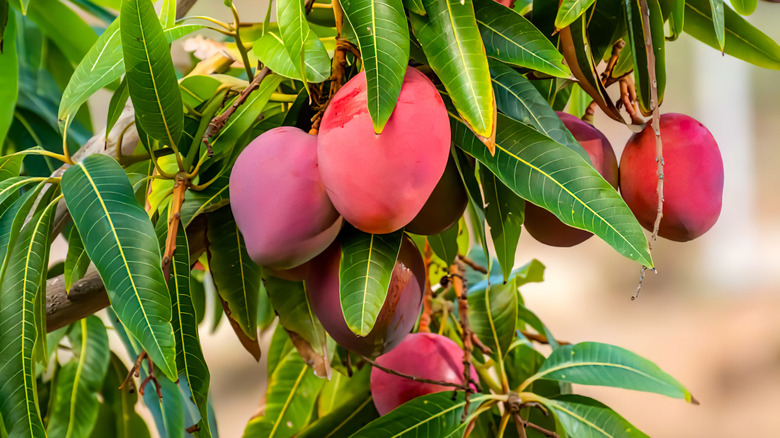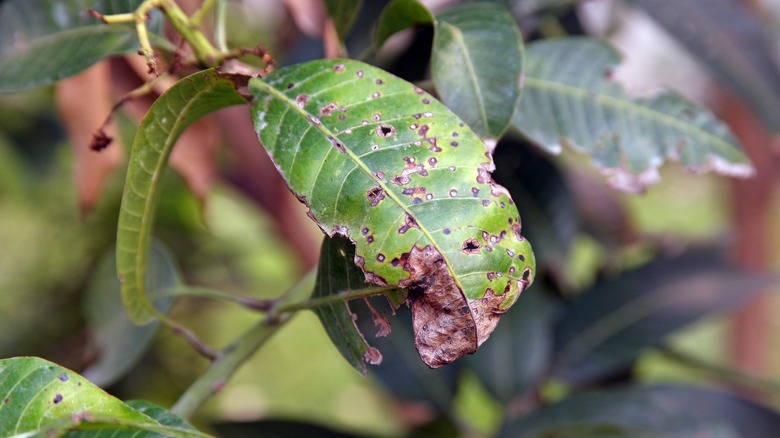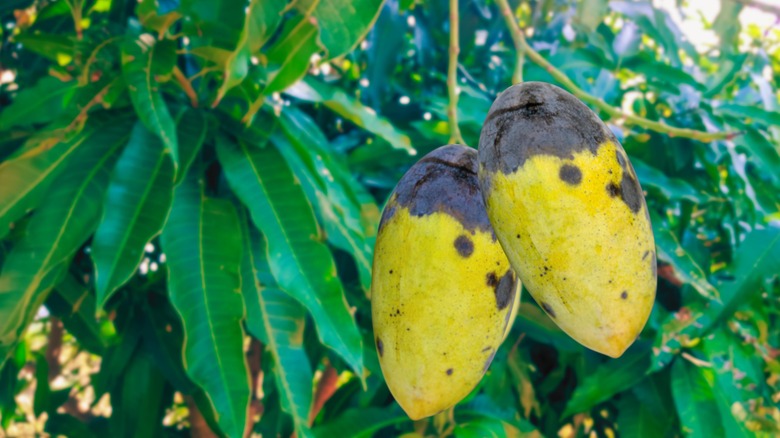The Worrying Reason Your Mango Tree Is Turning Black
Mangoes are palm-sized pieces of paradise. Whether you eat them raw with a dash of chamoy or toss them in a smoothie, they instantly evoke tropical vibes. Once considered exotic among American consumers, per capita consumption of mango fruit now exceeds that of blueberries, peaches and nectarines, and pears. The fruit's burgeoning popularity has prompted a plethora of tutorials for growing mango trees at home. Since they are tropical plants, mangos grow best in warm, humid locales like Florida, Southern California, Hawaii, and Puerto Rico. Unfortunately, fungi also thrive in warm, humid environments, and mango trees are susceptible to a variety of fungal diseases that cause the leaves, flowers, or fruit to turn black.
Mango trees are particularly prone to anthracnose, a common fungal infection that also results in rotting strawberries and causes avocado leaves to turn brown. Depending on the timing and severity of the infection, the trees may fail to bear fruit at all, or they may produce fruit that quickly rots. Prompt treatment is critical, and learning to identify the symptoms is key to catching the disease in the initial stages.
How do you identify an anthracnose infection in your mango tree?
In mango trees, anthracnose (also called mango blossom blight) is caused by the fungus Colletotrichum gloeosporioides. Fungal spores flourish in the presence of water, so anthracnose infections are more likely during periods of prolonged rainfall. Splashing raindrops and wind spread the disease by transporting spores to other parts of the plant or to nearby trees. Anthracnose attacks all parts of the tree and symptoms may appear on leaves, twigs, flowers, and fruits. Regular monitoring of your mango will make you more familiar with its normal appearance so you can easily identify signs of a diseased tree in the future.
The first signs of an anthracnose infection often include irregularly shaped brown spots on the upper and lower surfaces of leaves. Initially, these spots are more common along leaf edges, but left untreated, they can spread and cause the leaves to die and fall off. Small dark spots may also appear on flowers, killing them before fruit can form. Anthracnose rapidly infects developing fruit, but the fungus usually remains dormant until the fruit begins to ripen. As it matures, large, gray, or black sunken lesions may appear. Initially superficial and restricted to the skin, the lesions eventually penetrate deeper layers of the flesh causing the fruit to rot.
What can you do if your tree is infected with anthracnose?
Unfortunately, once your mango tree is infected with anthracnose, you'll never fully get rid of it. The disease can be managed but not cured. Fungicides, like mancozeb and copper oxychloride, are the most effective treatments. For optimal results, they should be applied to all parts of the tree every week or two until the fruit reaches maturity. While fungicides can suppress the symptoms of anthracnose and prevent it from spreading, the disease may reemerge, especially during persistent rain. To prevent reinfection in the subsequent growing seasons, you'll want to regularly apply fungicide as soon as flowers begin to appear.
Although anthracnose is common in mango trees, there are a few steps you can take to reduce the likelihood of an infection. First, plant only anthracnose-resistant varieties like Ataulfo and Tommy Atkins. Saplings are available at many nurseries, but you can also grow both of these mango trees from seeds. Other preventative measures include pruning overcrowded branches to promote air circulation and planting trees in full sun to allow the leaves, flowers, and fruit to dry quickly after a rain. Since the anthracnose fungus persists on dead plant materials, you'll also want to immediately remove any dead leaves, flowers, and twigs. With a bit of vigilance and a touch of TLC, your mango tree can produce fruit for several decades, allowing you to bask in tropical vibes for many years to come.


